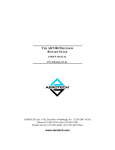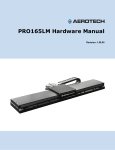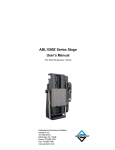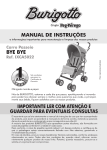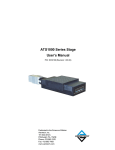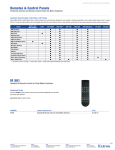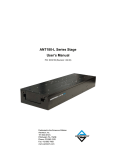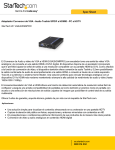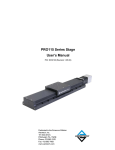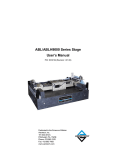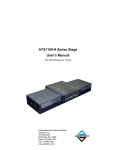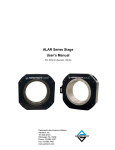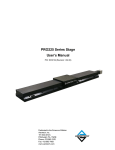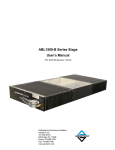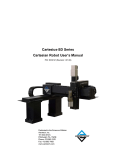Download ATS150 Series Stage User`s Manual
Transcript
ATS150 Series Stage User’s Manual P/N: EDA125 (Revision 1.01.00) Dedicated to the Science of Motion Aerotech, Inc. 101 Zeta Drive, Pittsburgh, PA, 15238 Phone: 412-963-7470 Fax: 412-963-7459 www.aerotech.com Product Registration Register online at: http://www.aerotech.com/prodreg.cfm Technical Support United States Headquarters: Phone: (412) 967-6440 Fax: (412) 967-6870 Email: [email protected] United Kingdom: Phone: +44 118 940 9400 Fax: +44 118 940 9401 Email: [email protected] Germany: Phone: +49 911 967 9370 Fax: +49 911 967 93720 Email: [email protected] Japan: Phone: +81(0)47-489-1741 (Sales) Phone: +81(0)47-489-1742 (Service) Fax: +81(0)47-489-1743 Email: [email protected] China: Phone: +852-3793-3488 Email: [email protected] Revision History Revision 1.01.00 March 21, 2011 Revision 1.00.00 March 10, 2006 Product names mentioned herein are used for identification purposes only and may be trademarks of their respective companies. © Aerotech, Inc. 2011 ATS150 Series Stage User's Manual Table of Contents Table of Contents Table of Contents List of Figures List of Tables iii v vii Chapter 1: Overview 1 1.1. Standard Features 1.2. Model Numbers 1.3. Safety Procedures and Warnings 1.4. EC Declaration of Incorporation Chapter 2: Installation 2.1. Unpacking and Handling the Stage 2.2. Preparing the Mounting Surface 2.3. Securing the Stage to the Mounting Surface 2.4. Attaching the Payload to the Stage 2.5. Electrical Installation 2.5.1. DC Servo Motor Wiring Chapter 3: Operating Specifications 3.1. Environmental Specifications 3.2. Accuracy and Temperature Effects 3.3. Basic Specifications 3.4. Life Expectancy and Load Capability 3.5. Optical Limit Switch Assembly 3.5.1. Limit Switch Operation 3.5.2. Limit Interface 3.6. Vacuum Operation 3.6.1. Special Guidelines Chapter 4: Maintenance 4.1. Lubrication Schedule 4.2. Lubrication and Cleaning Process 4.3. Important Notes on Lubrication 4.4. Recommended Lubricants and Cleaning Solvents 2 4 6 8 9 9 10 11 11 12 12 13 13 14 15 17 20 20 21 22 22 23 23 24 25 25 Appendix A: Warranty and Field Service 27 Appendix B: Technical Changes 29 Index 31 Reader's Comments 32 www.aerotech.com iii Table of Contents iv ATS150 Series Stage User's Manual www.aerotech.com ATS150 Series Stage User's Manual List Of Figures List of Figures Figure 1-1: Figure 1-2: Figure 1-3: Figure 2-1: Figure 3-1: Figure 3-2: Figure 3-3: Figure 3-4: Typical ATS150 Series Linear Positioning Stage ATS150 with Cutaway View of Ballscrew Components of a Typical Motor, Encoder, and ATS150 Series Stage Results of Coplanar Versus Non-Coplanar Mounting Load Capability and Travel Life of the ATS150 Stages Torque Required to Turn ATS150 Series Ball-screw with Various Loads and Leads ATS150 Internal View Showing Optical Limit Switch Assembly ATS150 Series Limit Switch Wiring www.aerotech.com 1 2 3 10 17 19 20 21 v List of Figures vi ATS150 Series Stage User's Manual www.aerotech.com ATS150 Series Stage User's Manual List of Tables List of Tables Table 1-1: Table 3-1: Table 3-2: Table 3-3: Table 3-4: Table 3-5: Table B-1: Table B-2: Model Numbering System Environmental Specifications ATS150 Series Positioning Stage Specifications Motor Specifications Applied Load Coeffcients Limit Interface Pin Assignments Current Changes (1.01.00) Archived Changes www.aerotech.com 4 13 15 16 18 21 29 30 vii List of Tables viii ATS150 Series Stage User's Manual www.aerotech.com ATS150 Series Stage User's Manual Overview Chapter 1: Overview This manual describes Aerotech’s ATS150 series of linear motor positioning stages. Figure 1-1 shows a typical ATS150 positioning stage. The ATS150 series are low profile linear positioning stages. These stages provide highly accurate positioning with travel ranges from 100 mm to 250 mm (4-10 in). They have a low profile, compact design, yet they are designed for high stiffness and stability. The ATS150 series uses a long life, linear motion guide (LMG) bearing system that provides ultra fine positioning resolution (up to 0.1 micron) with an average accuracy better than ± 0.7 micron/25 mm (± 0.00003 in/in). This chapter introduces standard and optional features of the ATS150 stages, explains the model numbering system, and gives general safety precautions. Figure 1-1: Typical ATS150 Series Linear Positioning Stage N O T E : Aerotech continually improves its product offerings, and listed options may be superseded at any time. Refer to the most recent edition of the Aerotech Motion Control Product Guide for the most current product information at www.aerotech.com. www.aerotech.com Chapter 1 1 Overview ATS150 Series Stage User's Manual 1.1. Standard Features ATS150 series stages use a precision ground ball-screw (see cutaway view in Figure 1-2) that is preloaded to eliminate backlash. High-quality duplex bearings are used to eliminate axial play, while the LMG bearing system provides high load capability, stiffness, and continuous carriage support over the entire travel distance. Internal contamination is prevented with integral bellows way-covers. The connecting nut on the ballscrew has wipers that prevent internal contamination of the drive and bearing system, thereby ensuring high accuracy over the expected travel life in excess of 100,000,000 inches. Figure 1-2: ATS150 with Cutaway View of Ballscrew Additional features of the ATS150 series stages include: l Optical limit switches and cushioned end stops l Aluminum alloy (standard) or steel construction (for severe temperature environments) l English or Metric mounting holes on the stage table (1/4-20 on a 1" square grid pattern or M6 on a 25 mm grid pattern) l Micro-stepping, DC servo motors or brushless servo motors l Vacuum preparation for operation to 10-6 torr. l High accuracy (HAL) stage option providing positioning accuracy of ±1 micron over full travel and a ±.25 micron bi-directional repeatability l Precision multi-axis configurations (such as XY and XYZ) having orthogonality within 5 arc seconds. Motors are mounted to a plate on one end of ATS150 series stages. A motor housing and encoder are optional on most models. A cable or set of cables carries motor power, encoder feedback as well as limit switch signals to the appropriate hardware devices (such as axis controllers and amplifiers). 2 Chapter 1 www.aerotech.com ATS150 Series Stage User's Manual Figure 1-3: Overview Components of a Typical Motor, Encoder, and ATS150 Series Stage N O T E : Motor and limit wiring can be integral (extending directly from the electrical housing) as shown in Figure 1-3, or it can attach to a connector located on the motor itself (depending on the model of motor housing ordered). www.aerotech.com Chapter 1 3 Overview ATS150 Series Stage User's Manual 1.2. Model Numbers The table below lists the available options. Aerotech continually improves its product offerings, and listed options may be superseded at any time. Refer to the most recent edition of the Aerotech Motion Control Product Guide for the most current product information at www.aerotech.com. Table 1-1: Model Numbering System Travel Distance ATS150-100 100 mm (4 in) travel stage with limits ATS150-150 150 mm (6 in) travel stage with limits ATS150-200 200 mm (8 in) travel stage with limits ATS150-250 250 mm (10 in) travel stage with limits Stage Construction Options /VAC3 Vacuum preparation of stage to 10 -3 torr /VAC6 Vacuum preparation of stage to 10 -6 torr /STEEL All steel construction High-Accuracy Linear Encoders -LN10AS High-accuracy linear encoder for ATS150-100; amplified sine output 1 Vpp (4 µm signal period); requires signal multiplier -LN15AS High-accuracy linear encoder for ATS150-150; amplified sine output 1 Vpp (4 µm signal period); requires signal multiplier Note: Internal signal multipliers available with A3200 amplifier products. Mounting and Grid Pattern -M Metric dimension mounting pattern and holes -U English dimension mounting pattern and holes Drive Screw -20P 2 mm/rev precision-ground ball screw -40P 4 mm/rev precision-ground ball screw Motor -BMS Brushless servomotor with connectors and 1000-line encoder; requires cable (BMS60-A-D25-E1000H/) -SM Stepping motor with connector and home marker pulse (one per rev); requires cable (101SMB2-HM/) -NM No motor or encoder Limits -NC Normally-closed end of travel limit switches (standard) -NO Normally-open end of travel limit switches -9DU With 9-pin limit connector -FLY With flying leads Options 4 -BRK23 24 VDC spring-set motor brake for NEMA 23 motor -FB150 Fold-back motor configuration -FB-BRK1 Fold-back motor configuration with 24 VDC spring-set motor brake for NEMA 23 motor Chapter 1 www.aerotech.com ATS150 Series Stage User's Manual Overview Table 1-1: Model Numbering System (continued) Coupling -NO COUPLING No coupling -STD COUPLING 0.25 in coupling -LGR MTR COUPLING 0.375 in coupling Accessories (to be ordered as separate line item) ALIGNMENT-NPA Non-precision XY assembly ALIGNMENT-NPAZ Non-precision XZ or YZ assembly ALIGNMENT-PA10 XY assembly; 10 arc sec orthogonal ALIGNMENT-PA10Z XZ or YZ assembly with L-bracket; 10 arc second orthogonal ALIGNMENT-PA5 XY assembly; 5 arc sec orthogonal ALIGNMENT-PA5Z XZ or YZ assembly with L-bracket; 5 arc second orthogonal HALAR High-accuracy system – linear error correction for accuracy and repeatability HALSF High-accuracy system – improved straightness and flatness HDZ2 English right-angle L-bracket; for ATS150-100 and ATS150-150 stages only HDZ2M Metric right-angle L-bracket; for ATS150-100 and ATS150-150 stages only HDZ2/VAC6 VAC6 prepared English right-angle L-bracket; for ATS150-100 and ATS150-150 stages only HDZ2M/VAC6 VAC6 prepared metric right-angle L-bracket; for ATS150-100 and ATS150-150 stages only www.aerotech.com Chapter 1 5 Overview ATS150 Series Stage User's Manual 1.3. Safety Procedures and Warnings The following statements apply throughout this manual. Failure to observe these precautions could result in serious injury to those performing the procedures and damage to the equipment. This manual and any additional instructions included with the stage should be retained for the lifetime of the stage. To minimize the possibility of electrical shock and bodily injury or death, disconnect all electrical power prior to making any electrical connections. To minimize the possibility of electrical shock and bodily injury or death when any electrical circuit is in use, ensure that no person comes in contact with the circuitry when the stage is connected to a power source. To minimize the possibility of bodily injury or death, disconnect all electrical power prior to making any mechanical adjustments. Moving parts of the stage can cause crushing or shearing injuries. All personnel must remain clear of any moving parts. Improper use of the stage can cause damage, shock, injury, or death. Read and understand this manual before operating the stage. If the stage is used in a manner not specified by the manufacturer, the protection provided by the stage can be impaired. Stage cables can pose a tripping hazard. Securely mount and position all stage cables to avoid potential hazards. 6 Chapter 1 www.aerotech.com ATS150 Series Stage User's Manual Overview Do not expose the stage to environments or conditions outside the specified range of operating environments. Operation in conditions other than those specified can cause damage to the equipment. The stage must be mounted securely. Improper mounting can result in injury and damage to the equipment. Use care when moving the stage. Manually lifting or transporting stages can result in injury. Only trained personnel should operate, inspect, and maintain the stage. This stage is intended for light industrial manufacturing or laboratory use. Use of the stage for unintended applications can result in injury and damage to the equipment. Before using this stage, perform an operator risk assessment to determine the needed safety requirements. www.aerotech.com Chapter 1 7 Overview ATS150 Series Stage User's Manual 1.4. EC Declaration of Incorporation Manufactorer: Aerotech, Inc. 101 Zeta Drive Pittsburgh, PA 15238 USA herewith declares that the product: Aerotech, Inc. ATS150 Stage is intended to be incorporated into machinery to constitute machinery covered by the Directive 2006/42/EC as amended; does therefore not in every respect comply with the provisions of this directive; and that the following harmonized European standards have been applied: EN ISO 12100-1,-2:2003+A1:2009 Safety of machinery - Basic concepts, general principles for design ISO 14121-1:2007 Safety of machinery - Risk assessment - Par 1: Principles EN 60204-1:2005 Safety of machinery - Electrical equipment of machines - Part 1: General requirements and further more declares that it is not allowed to put the equipment into service until the machinery into which it is to be incorporated or of which it is to be a component has been found and declared to be in conformity with the provisions of the Directive 2006/42/EC and with national implementing legislation, i.e. as a whole, including the equipment referred to in this Declaration. Authorized Representative: Address: Manfred Besold AEROTECH GmbH Süd-West-Park 90 D-90449 Nürnberg Name: Position: Location: Date: 8 Alex Weibel / Engineer Verifying Compliance Pittsburgh, PA March 21, 2011 Chapter 1 www.aerotech.com ATS150 Series Stage User's Manual Installation Chapter 2: Installation This chapter covers the mechanical aspects of setting up the stage, including proper stage handling techniques, how to prepare the mounting surface to accept the stage, how to secure the stage to the mounting surface and how to attach a payload. Also covered are the electrical aspects of setting of the stage, including motor wiring information, the optical limit switch assembly and limit/home wiring options. Installation must follow the instructions in this chapter. Failure to follow these instructions could result in injury and damage to the equipment. 2.1. Unpacking and Handling the Stage Carefully remove the stage from the protective shipping container. Set the stage on a smooth, flat, and clean surface. This is a simple, yet very important step in maintaining the integrity of the stage. Each stage has a label listing the system part number and serial number. These numbers contain information necessary for maintaining or updating system hardware and software. Locate this label and record the information for later reference. If any damage has occurred during shipping, report it immediately. Improper stage handling could adversely affect the stage’s performance. Therefore, use care when moving the stage. Manually lifting or transporting the stage can result in injury. Lift the stage only by the base. Do not use the ballscrew or motor as lifting points. www.aerotech.com Chapter 2 9 Installation ATS150 Series Stage User's Manual 2.2. Preparing the Mounting Surface In order for the ATS150 series stage to maintain accuracy, the mounting surface should be coplanar within 0.000010 in/in. For example, if the longest distance between the rectangular base hole pattern is 8 inches, then the mounting surface should be coplanar within 0.000080 inches. Adjustments to the mounting surface must be done before the stage is secured. Adjustments to the mounting surface must be done before the stage is secured. The effects of flatness on mounting are illustrated in Figure 2-1. Figure 2-1: Results of Coplanar Versus Non-Coplanar Mounting When an ATS150 series stage is mounted onto a non-coplanar surface the stage can be distorted as the mounting screws are tightened. This distortion can decrease the overall accuracy of the stage. N O T E : The stage base is precision machined and verified for flatness prior to stage assembly at the factory. If machining is required to achieve the desired flatness, it should be performed on the mounting surface rather than the stage base. Shimming should be avoided if possible. If shimming is required, it should be minimized to improve the rigidity of the system. 10 Chapter 2 www.aerotech.com ATS150 Series Stage User's Manual Installation 2.3. Securing the Stage to the Mounting Surface Manually position the stage table so that the access holes (0.5 in [75.0 mm] diameter) on the stage table are aligned with any two of the mounting holes (0.28 in [6,5 mm] diameter) on the under side of the stage. Install the appropriately sized screws though the access holes and secure the stage to the mounting surface. Repeat this process for each set of mounting holes. The stage must be mounted securely. Improper mounting can result in injury and damage to the equipment. N O T E : The stage table may offer a considerable amount of resistance when it is moved manually. This is especially true if the stage is fitted with a motor assembly. N O T E : If the stage is not connected to a power source, and is not equipped with an optional brake, it should be possible to move the stage table by hand with steady even pressure. Do not attempt to manually move the stage if it is connected to a power source or includes an integrated brake. 2.4. Attaching the Payload to the Stage To prevent damage to payloads, test the operation of the stage before the payload is attached to the stage table. When attaching a payload to the stage table, the mounting interface should be coplanar within 0.000010 in/in for valid accuracies. This can be achieved by scraping or shimming the mounting surface of the payload. It is recommended that feet or pads be used on the payload surface to minimize the amount of surface area that needs to be coplanar. www.aerotech.com Chapter 2 11 Installation ATS150 Series Stage User's Manual 2.5. Electrical Installation Electrical installation requirements will vary depending on stage options. Installation instructions in this section are for stages equipped with standard Aerotech motors intended for use with an Aerotech motion control system. Contact Aerotech for further information regarding stages that are otherwise configured. Aerotech motion control systems are adjusted at the factory for optimum performance. When the ATS150 series stage is part of a complete Aerotech motion control system, setup involves connecting a stage and motor combination to the appropriate drive chassis with the cables provided. Connect the provided cables to the motor and feedback connectors on the stage. Labels on the drive indicate the appropriate connections. Refer to your drive manuals and documentation for additional installation and operation information. In some cases, if the system is uniquely configured, a drawing showing system interconnects is supplied. Never connect or disconnect any electrical component or connecting cable while power is applied, or serious damage may result. 2.5.1. DC Servo Motor Wiring When stages are equipped with standard Aerotech DC motor and encoder combinations, refer to the appropriate motor manuals and documentation for additional installation and operation information. 12 Chapter 2 www.aerotech.com ATS150 Series Stage User's Manual Operating Specifications Chapter 3: Operating Specifications The surrounding environment and operating conditions can affect the performance and service life of the stage. This chapter provides information on ideal environmental and operating conditions. Also included are instructions for estimating load and torque required to turn the ballscrew given various loadings. 3.1. Environmental Specifications The environmental specifications for the ATS150 are listed in the following table. Table 3-1: Environmental Specifications Ambient Temperature Operating: 10° to 35° C (50° to 95° F) The optimal operating temperature is 20° C ±2° C (68° F ±4° F). If at any time the operating temperature deviates from 20° C degradation in performance could occur. Contact Aerotech for information regarding your specific application and environment. Storage: 0° to 40° C (32° to 104° F) in original shipping packaging Humidity Operating: 40 percent to 60 percent RH The optimal operating humidity is 50 percent RH. Storage: 30 percent to 60 percent RH, non-condensing in original packaging Altitude Operating: 0 to 2,000 m (0 to 6,562 ft) above sea level Contact Aerotech if your specific application involves use above 2,000 m or below sea level. Vibration Use the system in a low vibration environment. Excessive floor or acoustical vibration can affect stage and system performance. Contact Aerotech for information regarding your specific application. Dust Exposure The ATS150 stages have limited protection against dust, but not water. This equates to an ingress protection rating of IP50. Use Indoor use only Do not expose the stage to environments or conditions outside the specified range of operating environments. Operation in conditions other than those specified can cause damage to the equipment. www.aerotech.com Chapter 3 13 Operating Specifications ATS150 Series Stage User's Manual 3.2. Accuracy and Temperature Effects The ATS150 series stages are designed to have maximum accuracy at 68° F. The accuracy of the stages ball-screw is a key element in the overall positioning accuracy. An offset error can be expected if the temperature of the ball-screw differs from 68° F. As the temperature of the ball-screw increases, the actual position from the motor will be greater by a factor of Similarly, as the temperature of the ball-screw decreases, the actual positioning will be less by the same factor. The value specified in the "inches of travel" and "mm of travel" represent the distance from the center of the stage to the bearing on the motor end of the stage. N O T E : Ball-screw temperature is dependent on the speed of the stage and duty cycle. Higher speeds and duty cycles produce greater ball-screw heating. 14 Chapter 3 www.aerotech.com ATS150 Series Stage User's Manual Operating Specifications 3.3. Basic Specifications The ATS150 series positioning stage and motor specifications are provided in Table 3-2 and Table 3-3. Table 3-2: ATS150 Series Positioning Stage Specifications Basic Model ATS150-100 100 mm (4 in) Total Travel ATS150-150 150 mm (6 in) Bus Voltage Up to 160 VDC Apk Continuous Current Up to 2.3 A Arms Up to 1.6 A Feedback Noncontact Rotary Encoder (1000 line) 2 mm/rev lead 0.5 µm (20 µin) @ 4000 steps/rev Motor Resolution 4 mm/rev lead 1.0 µm (40 µin) @ 4000 steps/rev Motor Resolution LN Linear Encoder Maximum Travel Speed(1) Maximum Load(2) 0.001 µm - 0.2 µm (0.04 µin 8.0 µin) 115 mm/s (4.5 in/s) 4 mm/rev lead 230 mm/s (9.0 in/s) Horizontal 45.0 kg (99.2 lb) Vertical 25.0 kg (55.1 lb) Ball Screw Accuracy LN Ball Screw Standard Maximum Deviation Pitch and Yaw Nominal Stage Weight ±1.0 µm (±40 µin) +2,-4 µm (+80,-160 µin) +2,-5 µm (+80,-200 µin) +2,-8 µm (+80,-320 µin) +2,-10 µm (+80,-400 µin) HALAR(3) ±1.0 µm (±40 µin) N/A N/A Standard ±5.0 µm (±200 µin) N/A N/A HALAR(3) ±0.5 µm (±20 µin) Standard LN Differential N/A 25.0 kg (55.1 lb) HALAR(3) Straightness and Flatness N/A 2 mm/rev lead Side Repeatability (Bidirectional) ATS150-250 250 mm (10 in) Super Precision Ground Ball Screw/Brushless Servomotor (BMS60-A-D25-E1000H) Drive System Resolution ATS150-200 200 mm (8 in) ±1.0 µm (±40 µin) ±0.5 µm (±20 µin) N/A HALSF 1 µm/25 mm (40 µin/in) Standard 2 µm/25 mm (80 µin/in) HALSF Standard N/A ±1.0µm (±40 µin) ±1.5 µm (±60 µin) ±2.0 µm (±80 µin) ±3.0 µm (±120 µin) ±2.0 µm (±80 µin) ±3.0 µm (±120 µin) ±4.0 µm (±160 µin) ±5.0 µm (±200 µin) 8 arc sec 10 arc sec 12 arc sec 14 arc sec Less Motor 6.1 kg (13.4 lb) 7.5 kg (16.5 lb) 7.9 kg (17.4 lb) 8.4 kg (18.5 lb) With Motor 7.2 kg (15.9 lb) 8.6 kg (19.0 lb) 9.0 kg (19.8 lb) 9.5 kg (20.9 lb) Construction Aluminum Body/Stage and Table; Clear Anodize Finish (1) Excessive duty cycle may impact accuracy. (2) Payload specifications are for single axis system and based on ball screw and bearing life of 2500 km (100 million inches) of travel. (3) Available with Aerotech controllers. (4) Specifications are for single-axis systems, measured 50 mm above the tabletop. Performance of multi-axis systems is payload and workpoint dependent. Consult factory for multi-axis or non-standard applications. www.aerotech.com Chapter 3 15 Operating Specifications Table 3-3: ATS150 Series Stage User's Manual Motor Specifications BMS60 Model Winding Designation -A Performance Specifications (1,5) Stall Torque, Continuous (2) Peak Torque (3) Rated Speed Rated Power Output, Continuous Electrical Specifications Continuous Current, Stall (2) (3) Torque Constant (4,8) Motor Constant (2,4) Resistance, 25 °C (line to line) Inductance (line to line) Maximum Bus Voltage Thermal Resistance Number of Poles 0.33 oz-in 46.2 N-m 1.31 oz-in 184.9 rpm 4,000 watts 112.0 Volts pk / krpm 19.0 (5) BEMF Constant (line to line, max) Peak Current, Stall N-m Amp pk 2.3 Amp rms 1.6 Amp pk 9.2 Amp rms 6.5 N-m / Amp pk 0.14 oz-in / Amp pk 20.1 N-m / Amp rms 0.20 oz-in / Amp rms 28.4 N-m / √W 0.050 oz-in / √W 7.02 ohms 8.4 mH 1.30 VDC 340 °C / W 1.73 P 8 (1) Performance is dependent upon heat sink configuration, system cooling conditions, and ambient temperature (2) Values shown @ 75 °C rise above a 25 °C ambient temperature, with housed motor mounted to a 250 mm x 250 mm x 6 mm aluminum heat sink (3) Peak torque assumes correct rms current, consult Aerotech (4) Torque Constant and Motor Constant specified at stall (5) All performance and electrical specifications +/- 10 percent (6) Maximum winding temperature is 100 °C, Thermistor trips at 100 °C (7) Ambient operating temperature range: 0 °C - 25 °C, consult Aerotech for performance in elevated ambient temperatures (8) All Aerotech amplifiers are rated Apk; use torque constant in N-m/Apk when sizing 16 Chapter 3 www.aerotech.com ATS150 Series Stage User's Manual Operating Specifications 3.4. Life Expectancy and Load Capability The accuracy specification of ATS150 series stages is measured at the center of travel (with no load), located 1.75 inches above the table, with the stage in a horizontal position. It is recommended the load be symmetrically distributed (the payload should be centered on the stage table and the entire stage should be centered on the support structure). For cantilever loading, refer to Figure 3-1 for a graph of the maximum allowable load versus the distance of the load's center of gravity to the center of the stage table. Figure 3-1: Load Capability and Travel Life of the ATS150 Stages Load capacity and life expectancy are inversely related (that is, as loading increases, life expectancy will decrease). The ball-screw is usually the critical component when determining life expectancy. To determine the life expectancy in a given application, refer to the loading vs. travel life graph in Figure 3-1. Be sure to consider dynamic loading when using the ATS150 series stage for high-speed applications. Life expectancy is calculated using the following steps. 1. Determine the loading percentage of the stage. Use the following equation: 2. Multiply the result by the proper factor from the Applied Load Coefficient Table (Table 3-4). www.aerotech.com Chapter 3 17 Operating Specifications ATS150 Series Stage User's Manual 3. Refer to the loading vs. travel life graph in Figure 3-1. Table 3-4: Applied Load Coeffcients Operating Conditions Smooth operation (no shocks) Factor 1.0 Normal operating conditions 1.5 In applications using a cantilevered load, the life expectancy is calculated as follows: 1. Determine the equivalent, direct-acting loading force of the applied load. Use the following equation: 2. Use the cantilever load chart (see Figure 3-1) to determine the maximum direct loading force using the following equation. 3. Calculate the loading percentage using the calculated loading forces. 4. Multiply the result by the proper factor from the Applied Load Coefficient Table (Table 3-4). 5. Refer to the loading vs. travel life graph in Figure 3-1. 18 Chapter 3 www.aerotech.com ATS150 Series Stage User's Manual Operating Specifications The following conversions can be used during load calculations. 1 kg = 2.2 pounds 2.54 cm = 1 in 1 kg-cm = 13.9 oz-in 16 oz-in-sec2 = 1 lb-in-sec2 1 revolution approximately equals 6.28 radians. The approximate amount of torque required to turn the ball-screw of an ATS150 series stage can be found from Figure 3-2. For ATS150 series stages, the efficiency is rated at 90 percent (0.90). Maximum load is 100 pounds. Figure 3-2: Torque Required to Turn ATS150 Series Ball-screw with Various Loads and Leads www.aerotech.com Chapter 3 19 Operating Specifications ATS150 Series Stage User's Manual 3.5. Optical Limit Switch Assembly ATS150 series stages are equipped with optical limit switch assemblies (#690B1371), which are used to indicate maximum travel condition. 3.5.1. Limit Switch Operation Limit switches are mounted perpendicularly to table travel at each end of the stage, and have an emitting light source and detector. When the carriage interrupts the light path from the emitter to the detector, a clockwise (CW) or counter-clockwise (CCW) limit signal (active low) will indicate an over travel condition. Figure 3-3: ATS150 Internal View Showing Optical Limit Switch Assembly If the stage is driven approximately 1.5 mm beyond the electrical limit, it will encounter the mechanical stop. Although the operating speed of the stage might be relatively slow, damage to the stage could result. Unless specifically modified, the CW limit is activated when the stage table is at the end of travel opposite the motor end. 20 Chapter 3 www.aerotech.com ATS150 Series Stage User's Manual Operating Specifications 3.5.2. Limit Interface A six-pin printed circuit board connector is provided to facilitate wiring of the limit interface. The mating connector is AMP part number 640234-6. Table 3-5: Limit Interface Pin Assignments Pin# J1-1 Function +5V input Notes +5V at 25mA (source 1mA and sink 2.6 mA) or +12V at 25mA (source 3mA and sink 19mA [DJ0]) (For +12V @ 25mA, remove wire jumper 1-2) J1-2 Reserved J1-3 Signal common J1-4 Reserved J1-5 CCW limit-n Active low (4049 CMOS output) J1-6 CW Limit-n Active low Figure 3-4: ATS150 Series Limit Switch Wiring The CCW Limit-N output equals a logical 1 when the limit is not active. Typically, this is a value of 2.4 V at 0.8 mA. The CCW limit-N output equals a logical 0 when the limit is active. Typically, this is a value of 0.4 V at 12.8 mA. The CW Limit-N output behaves similarly. N O T E : The terms clockwise (CW) and counter-clockwise (CCW) refer to the rotation direction of the motor while looking into the shaft of the motor. For ATS150 series stages, a clockwise (CW) rotation of the motor causes the stage table to move away from the motor. Conversely, a counter-clockwise (CCW) rotation of the motor causes the stage table to move toward the motor. The exception is if an optional "foldback" motor is used, in which case the directions are reversed. www.aerotech.com Chapter 3 21 Operating Specifications ATS150 Series Stage User's Manual 3.6. Vacuum Operation As an option, Aerotech will prepare the ATS150 series stage for operation in a vacuum environment. As part of this preparation, meticulous attention to detail during modification, cleaning and assembly results in a stage with optimal performance in high vacuum applications (10-6 torr). This preparation includes: l Lubrication with vacuum-compatible lubricants (see Section 4.4. for lubricants) l Exclusive use of materials with excellent vacuum outgas performance l Elimination of situations that may allow gases to become temporarily trapped during pump down. l Extensive cleaning and bake-out prior to special assembly in a clean environment and packing in a nitrogen-filled bag. 3.6.1. Special Guidelines To ensure that the stage will continue to perform well in the vacuum environment, follow the guidelines listed below (in addition to standard handling, installation and lubrication guidelines outlined earlier in this manual). 1. Do not remove the stage from the sealed bag until it is ready for use. Use Teflon gloves in a clean environment to prevent any contaminants from adhering to the surface of the stage. 2. During the installation process use cleaned, vented stainless steel fasteners when securing the stage. A motor cover and cable connector might be supplied with the stage motor. These should be removed before the stage is used in vacuum applications. 3. In a vacuum environment, the lack of convective heat transfer could result in excessive motor operating temperatures. This, coupled with the viscous nature of vacuum-compatible greases, might make it necessary to de-rate performance specifications. To reduce the amount of heat generated, Aerotech offers special controllers that reduce the current supplied to the motor when it is in an idle state. Contact Aerotech for assistance. 22 Chapter 3 www.aerotech.com ATS150 Series Stage User's Manual Maintenance Chapter 4: Maintenance This chapter will cover information about intervals between lubrications, detail the lubrication and inspection process, and cover which lubricants are recommended for use. N O T E : The bearing area must be kept free of foreign matter and moisture; otherwise, the performance and life expectancy of the stage will be reduced. Always operate the stage with the hard cover and side seals in place to help keep dirt out. To minimize the possibility of bodily injury, confirm that all electrical power is disconnected prior to making any mechanical adjustments. 4.1. Lubrication Schedule Lubricant inspection and replenishment in ATS150 series stages depends on conditions such as duty cycle, speed, and the environment. An inspection interval of once per month is recommended until a trend develops for the application. Longer or shorter intervals may be required to maintain the film of lubricant on the bearing surfaces. In general, ball-screws and linear bearings require lubricant after 20 million inches of travel. The ball-screw end bearings and motor bearings are shielded, and should not need to be re-lubricated under normal use. www.aerotech.com Chapter 4 23 Maintenance ATS150 Series Stage User's Manual 4.2. Lubrication and Cleaning Process The lubrication and cleaning process is outlined in the steps that follow. Before beginning lubrication, please see Section 4.4. for recommended lubricants. 1. Drive the stage table to one end of travel and remove power to the stage. 2. Remove the socket head screws on the edges of the stage table and pull the bellows way-covers back toward the edge of the stage to reveal the inside of the stage. 3. Remove any accumulated dust or debris from the inside of the assembly. 4. Remove any dirty or dried lubricant from the lead-screw/ball-screw. Use a clean cloth with a side-to-side motion to clean the thread roots. Manually turn the ball-screw to clean its entire circumference. A cotton swab soaked in solvent may be used to remove stubborn debris. 5. Clean the end of the ball-screw nut and wiper with a clean cloth or cotton swab. These areas can be accessed from the underside of the stage. 6. Clean the linear bearing guides using a similar technique. 7. After the solvent has evaporated (if solvent is used), apply a thin, continuous film of lubricant to the leadscrew/ball-screw threads and linear bearing guides. A good quality, natural bristle artist's brush makes an excellent applicator. 8. Refasten the bellows way-covers and screws to the stage table. 9. Restore power to the stage, drive the stage table to the opposite end of travel, and remove power. 10. Repeat steps 2 through 7. To minimize the possibility of bodily injury, confirm that all electrical power is disconnected prior to making any mechanical adjustments. 24 Chapter 4 www.aerotech.com ATS150 Series Stage User's Manual Maintenance 4.3. Important Notes on Lubrication When cleaning and lubricating components of the ATS150 series stages: 1. Be sure to use a clean, dry, soft, and lint–free cloth for cleaning. 2. Take the opportunity during the lubrication procedure to inspect the linear motion guides for any damage or signs of wear. 3. In applications that have multiple stages bolted together to form multiaxis systems, the orthogonality can be altered upon loosening the stage tables of the support stages. In this case, lubricant should be applied with a hypodermic needle through the aperture hole in the base of the stage (or the optional aperture in the stage table). Otherwise, a master square must be used to realign the XY or YZ orthogonality. 4. Further disassembly of the stage is not recommended because proper assembly and calibration can only be done at the factory. 4.4. Recommended Lubricants and Cleaning Solvents For standard environments, use Dow Corning BR2 on the ball-screw and the linear bearings. For vacuum environments use Castrol Braycote 602 EF on the ballscrew and linear bearings. www.aerotech.com Chapter 4 25 Maintenance 26 ATS150 Series Stage User's Manual Chapter 4 www.aerotech.com ATS150 Series Stage User's Manual Warranty and Field Service Appendix A: Warranty and Field Service Aerotech, Inc. warrants its products to be free from defects caused by faulty materials or poor workmanship for a minimum period of one year from date of shipment from Aerotech. Aerotech's liability is limited to replacing, repairing or issuing credit, at its option, for any products that are returned by the original purchaser during the warranty period. Aerotech makes no warranty that its products are fit for the use or purpose to which they may be put by the buyer, where or not such use or purpose has been disclosed to Aerotech in specifications or drawings previously or subsequently provided, or whether or not Aerotech's products are specifically designed and/or manufactured for buyer's use or purpose. Aerotech's liability or any claim for loss or damage arising out of the sale, resale or use of any of its products shall in no event exceed the selling price of the unit. Aerotech, Inc. warrants its laser products to the original purchaser for a minimum period of one year from date of shipment. This warranty covers defects in workmanship and material and is voided for all laser power supplies, plasma tubes and laser systems subject to electrical or physical abuse, tampering (such as opening the housing or removal of the serial tag) or improper operation as determined by Aerotech. This warranty is also voided for failure to comply with Aerotech's return procedures. Laser Products Claims for shipment damage (evident or concealed) must be filed with the carrier Return Procedure by the buyer. Aerotech must be notified within (30) days of shipment of incorrect materials. No product may be returned, whether in warranty or out of warranty, without first obtaining approval from Aerotech. No credit will be given nor repairs made for products returned without such approval. Any returned product(s) must be accompanied by a return authorization number. The return authorization number may be obtained by calling an Aerotech service center. Products must be returned, prepaid, to an Aerotech service center (no C.O.D. or Collect Freight accepted). The status of any product returned later than (30) days after the issuance of a return authorization number will be subject to review. After Aerotech's examination, warranty or out-of-warranty status will be determined. If upon Aerotech's examination a warranted defect exists, then the product(s) will be repaired at no charge and shipped, prepaid, back to the buyer. If the buyer desires an airfreight return, the product(s) will be shipped collect. Warranty repairs do not extend the original warranty period. Returned Product Warranty Determination After Aerotech's examination, the buyer shall be notified of the repair cost. At such Returned Product time, the buyer must issue a valid purchase order to cover the cost of the repair and Non-warranty Deterfreight, or authorize the product(s) to be shipped back as is, at the buyer's mination expense. Failure to obtain a purchase order number or approval within (30) days of notification will result in the product(s) being returned as is, at the buyer's expense. Repair work is warranted for (90) days from date of shipment. Replacement components are warranted for one year from date of shipment. At times, the buyer may desire to expedite a repair. Regardless of warranty or outof-warranty status, the buyer must issue a valid purchase order to cover the added rush service cost. Rush service is subject to Aerotech's approval. www.aerotech.com Appendix A Rush Service 27 Warranty and Field Service ATS150 Series Stage User's Manual On-site Warranty If an Aerotech product cannot be made functional by telephone assistance or by Repair sending and having the customer install replacement parts, and cannot be returned to the Aerotech service center for repair, and if Aerotech determines the problem could be warranty-related, then the following policy applies: Aerotech will provide an on-site field service representative in a reasonable amount of time, provided that the customer issues a valid purchase order to Aerotech covering all transportation and subsistence costs. For warranty field repairs, the customer will not be charged for the cost of labor and material. If service is rendered at times other than normal work periods, then special service rates apply. If during the on-site repair it is determined the problem is not warranty related, then the terms and conditions stated in the following "On-Site Non-Warranty Repair" section apply. On-site Non-warranty If any Aerotech product cannot be made functional by telephone assistance or purRepair chased replacement parts, and cannot be returned to the Aerotech service center for repair, then the following field service policy applies: Aerotech will provide an on-site field service representative in a reasonable amount of time, provided that the customer issues a valid purchase order to Aerotech covering all transportation and subsistence costs and the prevailing labor cost, including travel time, necessary to complete the repair. Company Address Aerotech, Inc. 101 Zeta Drive Pittsburgh, PA 15238-2897 28 Phone: (412) 963-7470 Fax: (412) 963-7459 Appendix A www.aerotech.com ATS150 Series Stage User's Manual Technical Changes Appendix B: Technical Changes Table B-1: Current Changes (1.01.00) Section(s) Affected All General Information Complete revision of style and formatting. Some sections were moved or combined with other sections. No technical information was altered as part of this change. Section 1.2. Updated model numbers Section 1.4. Added section Section 3.1. Added section Chapter 2: Installation, Section 2.1. , Section 2.3. , Section 2.5. , and Section 1.3. Added safety information and warnings Section 0.1. Revised specifications, added motor specifications Section 3.5.1. Changed warning to specify distance in millimeters Section 4.4. Changed recommended lubricants www.aerotech.com Appendix B 29 Technical Changes Table B-2: Revision 1.00.00 30 ATS150 Series Stage User's Manual Archived Changes Section(s) Affected -- General Information New manual Appendix B www.aerotech.com Index ATS150 Series Stage User's Manual Index N Non-Coplanar A Accuracy 14 Attaching the Payload 11 10 O Optical Limit Switch Assembly 20 B P Basic Specifications 15 Preparing the Mounting Surface 10 C S cable 12 Coplanar 10 safety procedures 6 Securing the Stage to the Mounting Surface Standard Features D DC Servo Motor Wiring 11 2 12 T Declaration of Incorporation 8 Temperature Effects E Electrical Installation 12 Environmental Specifications 13 14 Travel Distance 1 Travel Life 2 U Unpacking and Handling the Stage L Life Expectancy 17 Limit Interface 21 Limit Switch Assembly 20 Limit Switch Operation 20 Load Capability 17 9 V Vacuum Operation 22 W Warnings 6 Lubricants Recommended 25 Lubrication and Cleaning 24 Lubrication Schedule 23 M Model Numbers 9 model numbers 9 multiaxis combinations www.aerotech.com 25 Index 31 Reader's Comments ATS150 Series Stage Manual P/N: EDA125, March 21, 2011 Revision 1.01.00 Please answer the questions below and add any suggestions for improving this document. Is the manual: Yes No Adequate to the subject Well organized Clearly presented Well illustrated How do you use this document in your job? Does it meet your needs? What improvements, if any, would you like to see? Please be specific or cite examples. Stage/Product Details Name Model # Title Serial # Company Name Date Shipped Address Customer Order # Aerotech Subsidiary Order # Email Mail your comments to: Fax to: Aerotech, Inc. 101 Zeta Drive Pittsburgh, PA 15238 U.S.A. 412-967-6870 Email: [email protected]








































